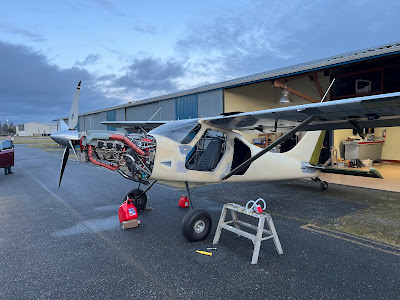I tripped across a Service Bulletin from Airmaster (SB #22).
The issue: In 'high vibration' environments / engines, the brush assembly in the motor can crack. This SB affects version 1 and 2 of the pitch change motors. I have version 2A.
Discussing with the US distributor, he had not heard of this SB. He also mentioned that because the UL engines are so smooth this should not be an issue. However, might as well do it... the irony is I had just torqued the hub onto the flange the day I discovered this. No big deal, except I will need some new nordlock washers.
The procedure is very detailed on how to extract the motor. I opted to take everything apart (the procedure says it can be done in place).
Only 1 issue: In step 4, you remove the 'riv-screws' on the motor clamp with a 2.5mm hex key. The first one came out no problem. #2 just spun. #3 came out fine... and the rest just spun as well.
I called Airmaster... they have never seen this before. "Do whatever you need to do to remove the rivscrews, and we will replace whatever parts are damaged.". We agreed that an easy out would do the job... it was 7PM at night when I discovered this (in a cold dark hangar), so figured I would do this the next day. As I was packing up, I had the brainwave that a thin slotted screw driver tapped into the head with a hammer may do the job... and it did.
Back in business! Everything packed and ready to ship. Airmaster says the upgrade will take about a week once they receive it.
They received it on Fri, Jan 17 2025. Return ship on Thu, Jan 23 (NZ time). Should have it on Wed, Jan 29.
Per Airmaster tech support, they have replaced my motor with a new Maxon carbon brush motor as it 'is more suited for my engine'. Both Tracy and Ray have been running with the Faulhaber motor for YEARS... so I asked why? The new motor is a carbon brush motor, and is 'worth more' than the previous. Cut and paste from the email...
The maxon motor you are receiving is also a carbon-brushed motor, however we have modified the original design so that it is more resilient to vibration, this is due to the implementation of thicker brush braids, higher-pressure springs, and an overall more resilient design that puts less strain on the brushes leads.
The UL520T engine may be considered smooth but it is still a direct drive engine so there is less of a damping effect on the prop.
Will see... looking forward to it.
On a related note, in talking to Ray, Airmaster is working on a new controller that will interface with the ECU and provide true 'one lever' operation. This will allow constant speed props to be used with LSA (in the US). Sounds very cool...
Motor received back from New Zealand! Reassembly fairly straight forward, except that the motor wires on the new assembly are in a different location, and require different routing.
The above pic was simply to check I had it right... sent to Jack @ Airmaster for confirmation. Now I can route everything neatly and finish reassembly.
Prop is all back on and done and tested. Glad this one is behind me.












